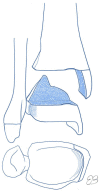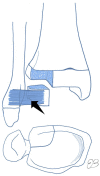Ankle fractures in children
- PMID: 34377551
- PMCID: PMC8335959
- DOI: 10.1302/2058-5241.6.200042
Ankle fractures in children
Abstract
Ankle fractures are common in children, and they have specific implications in that patient population due to frequent involvement of the physis in a bone that has growth potential and unique biomechanical properties.Characteristic patterns are typically evident in relation to the state of osseous development of the segment, and to an extent these are age-dependent.In a specific type known as transitional fractures - which occur in children who are progressing to a mature skeleton -a partial physeal closure is evident, which produces multiplanar fracture patterns.Computed tomography should be routine in injuries with joint involvement, both to assess the level of displacement and to facilitate informed surgical planning.The therapeutic objectives should be to achieve an adequate functional axis of the ankle without articular gaps, and to protect the physis in order to avoid growth alterations.Conservative management can be utilized for non-displaced fractures in conjunction with strict radiological monitoring, but surgery should be considered for fractures involving substantial physeal or joint displacement, in order to achieve the therapeutic goals. Cite this article: EFORT Open Rev 2021;6:593-606. DOI: 10.1302/2058-5241.6.200042.
Keywords: Salter–Harris fractures of the tibia; paediatric ankle; physeal ankle fracture.
© 2021 The author(s).
Conflict of interest statement
ICMJE Conflict of interest statement: The author declares no conflict of interest relevant to this work.
Figures


























References
-
- Rapariz JM, Martín S. Fracturas de tobillo. In: de Pablos J, González P, eds. Fracturas infantiles: conceptos y principios. Pamplona, la Coruña: MBA, 2005:453–462.
-
- Peterson HA. Distal tibia. In: Peterson HA, ed. Epiphyseal growth plate fractures. Berlin, Heidelberg: Springer, 2007:273–388.
-
- Birch JG. Growth and development. In: Herring J, Tachdjian MO, eds. Tachdjian’s pediatric orthopaedics. Fourth ed. Philadelphia, PA: Saunders, 2008:3–22.
-
- Pfeifer CM, Hammer MR, Mangona KL, Booth TN. Non-accidental trauma: the role of radiology. Emerg Radiol 2017;24:207–213. - PubMed
Publication types
LinkOut - more resources
Full Text Sources

